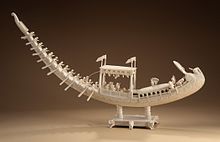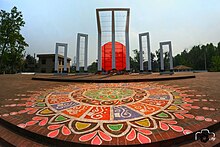
Back Bengaalse alfabet Afrikaans ألفبائية بنغالية Arabic Alfabetu bengalí AST Бенгалска писменост Bulgarian বাংলা লিপি Bengali/Bangla Skritur banglaek Breton Alfabet bengalí Catalan Bengálské písmo Czech Bengalische Schrift German Alfabeto bengalí Spanish
This article has multiple issues. Please help improve it or discuss these issues on the talk page. (Learn how and when to remove these messages)
|
| Bengali alphabet বাংলা বর্ণমালা বা লিপি | |
|---|---|
 | |
| Script type | Abugida |
Time period | 11th century to the present[1] |
| Direction | Left-to-right |
| Official script | for Bengali language and Meitei language[2][3] |
| Region | Bengal |
| Languages | Bengali, Sanskrit, Kokborok, Kudmali, Hajong, Bishnupriya Manipuri, Meitei |
| Related scripts | |
Parent systems | |
Sister systems | Assamese and Tirhuta |
| ISO 15924 | |
| ISO 15924 | Beng (325), Bengali (Bangla) |
| Unicode | |
Unicode alias | Bengali |
| U+0980–U+09FF | |
| Part of a series on the |
| Culture of Bengal |
|---|
 |
| History |
| Cuisine |
| Part of a series on the |
| Culture of Bangladesh |
|---|
 |
| Brahmic scripts |
|---|
| The Brahmi script and its descendants |

The Bengali script or Bangla alphabet (Bengali: বাংলা বর্ণমালা, romanized: Bāṅlā bôrṇômālā) is the alphabet used to write the Bengali language based on the Bengali-Assamese script, and has historically been used to write Sanskrit within Bengal. It is one of the most widely adopted writing systems in the world (used by over 265 million people).[5] It is one of the official scripts of the Indian Republic. It is used as the official script of the Bengali language in Bangladesh, West Bengal, Tripura, and Barak valley of Assam. It was the sole official script for the Meitei language in Manipur until the passage of the Manipur Official Language (Amendment) Act, 2021.[6]
From a classificatory point of view, the Bengali writing system is an abugida, i.e. its vowel graphemes are mainly realised not as independent letters, but as diacritics modifying the vowel inherent in the base letter they are added to. It is written from left to right and uses a single letter case, which makes it a unicameral script, as opposed to a bicameral one like the Latin script. It is recognisable, as are some other Brahmic scripts, by a distinctive horizontal line known as a śirorekhā (शिरोरेखा) running along the tops of the letters that links them together. The Bengali writing system is less blocky, however, and presents a more sinuous and fluid shape than the Devanagari script, which visually has harder edges in its orthography.[7]
- ^ "Ancient Scripts". Archived from the original on 16 November 2010. Retrieved 20 March 2007.
- ^ "GAZETTE TITLE: The Manipur Official Language (Amendment) Act, 2021". manipurgovtpress.nic.in. Archived from the original on 6 March 2023. Retrieved 3 February 2023.
"Manipuri Language" means Meeteilon written in Meetei Mayek and spoken by the majority of Manipur population: Provided that the concurrent use of Bengali Script and Meetei Mayek shall be allowed in addition to English language, for a period up to 10 (ten) years from the date of commencement of this Act.
- ^ "Manipuri language and alphabets". omniglot.com. Archived from the original on 27 January 2023. Retrieved 3 February 2023.
- ^ Daniels, Peter T. (2008). "Writing systems of major and minor languages". In Kachru, Braj B.; Kachru, Yamuna; Sridhar, S. N. (eds.). Languages in South Asia. Cambridge University Press. pp. 285–308. ISBN 978-0-521-78141-1.
- ^ "Bengali alphabet". Archived from the original on 26 January 2008. Retrieved 11 June 2005.
- ^ "GAZETTE TITLE: The Manipur Official Language (Amendment) Act, 2021". manipurgovtpress.nic.in. Archived from the original on 6 March 2023. Retrieved 3 February 2023.
"Manipuri Language" means Meeteilon written in Meetei Mayek and spoken by the majority of Manipur population: Provided that the concurrent use of Bengali Script and Meetei Mayek shall be allowed in addition to English language, for a period up to 10(ten) years from the date of commencement of this Act.
- ^ George Cardona and Danesh Jain (2003), The Indo-Aryan Languages, Routledge, ISBN 978-0-415-77294-5